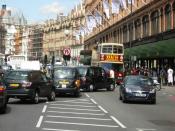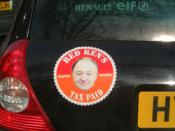Despite the size of London, much of the main tourist attraction is focused on a relatively small region on the north bank of the Thames. Within a short distance of each other are: Westminster Abbey, the London Eye, Buckingham Palace, West End, Trafalgar square and Covent Garden. As well as these tourist attractions are the financial and business sectors based in the City. This therefore makes Central London a very congested area and difficult to travel in. It has been estimated that London loses between ã2-4 million every week in terms of lost time caused by congestion and because of this something radical needed to be done. To solve the problem of congestion in Central London, the Mayor of London, Ken Livingston introduced a congestion charge pay scheme on February 17th 2003. The total budget to implement the scheme is ã200 million and covers 8 square miles3. It works by a network of camera sites, capturing those entering and exiting the Central London zone.
There are approximately 500 CCTV-type cameras which are all congestion charge related. The camera reads the number plate of the vehicle and is stored on a computer system and matched against a database of those who have registry to pay. This scheme requires drivers to pay ã5 per day if they wish to continue driving in Central London during the schemes hours of operation: between 7am and 6.30pm, Monday to Friday4. All vehicles driving across the ã5 charge zone will have to pay, either by phone, internet or retail outlet. This ensures that those using valuable and congested road space make a financial contribution which is re-invested into transport for London. Not only does this clear up the roads for those who are using a car, making journey times quicker and more reliable, but it...


